
Cappuccino is an espresso-based coffee drink that is traditionally prepared with steamed milk including a layer of milk foam.

Espresso is a concentrated form of coffee produced by forcing hot water under high pressure through finely-ground coffee beans. Originating in Italy, espresso has become one of the most popular coffee-brewing methods worldwide. It is characterized by its small serving size, typically 25–30 ml, and its distinctive layers: a dark body topped with a lighter-colored foam called crema.

A barista is a person, usually a coffeehouse employee, who prepares and serves espresso-based coffee drinks and other beverages.

Caffè latte, also known as caffè e latte or caffellatte, less correct caffelatte, often shortened to just latte in English, is a coffee drink of Italian origin made with espresso and steamed milk, traditionally served in a glass. Variants include the chocolate-flavored mocha or replacing the coffee with another beverage base such as masala chai, mate, matcha, turmeric or rooibos; alternatives to milk, such as soy milk, coconut milk, almond milk or oat milk, are also used.
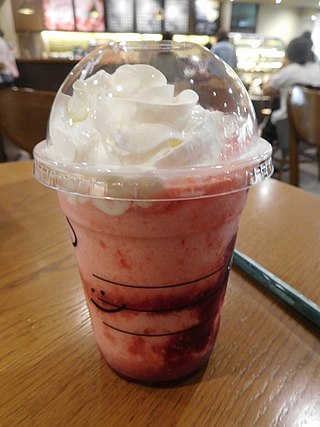
Frappuccino is a line of blended iced coffee drinks sold by Starbucks. It may consist of coffee or crème base, blended with ice and ingredients such as flavored syrups and usually topped with whipped cream and or spices. It may also include blended Starbucks refreshers. Frappuccinos are also sold as bottled coffee beverages in grocery stores, convenience stores and from vending machines.

An ice cream float or ice cream soda, also known as an ice cream spider in Australia and New Zealand, is a chilled beverage that consists of ice cream in either a soft drink or a mixture of flavored syrup and carbonated water.
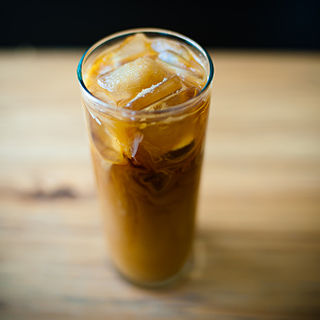
Iced coffee is a coffee beverage served cold. It may be prepared either by brewing coffee normally and then serving it over ice or in cold milk or by brewing the coffee cold. In hot brewing, sweeteners and flavoring may be added before cooling, as they dissolve faster. Iced coffee can also be sweetened with pre-dissolved sugar in water.

A caffè mocha, also called mocaccino, is a chocolate-flavoured warm beverage that is a variant of a caffè latte, commonly served in a glass rather than a mug. Other commonly used spellings are mochaccino and also mochachino. The name is derived from the city of Mokha, Taiz Governorate, Yemen, which was one of the centres of early coffee trade. Like latte, the name is commonly shortened to just mocha.
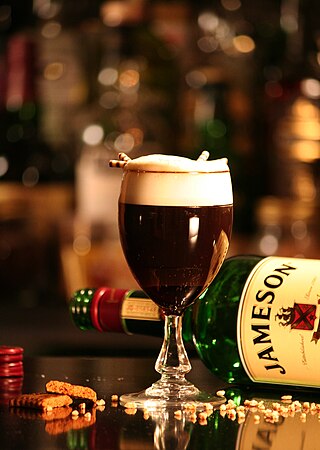
A liqueur coffee is a caffeinated alcoholic drink that consists of a shot of liqueur, mixed with coffee. It is typically served in a liqueur glass, often accompanied with cream and sugar. Coffee liqueur beverages are served in different fashions and can be found throughout many countries. One of the most popular liqueur coffee beverage is commonly known as Irish coffee. Liqueur coffee beverages are largely classified as cocktails as well as digestifs which are aimed at aiding the digestive process typically after a meal.
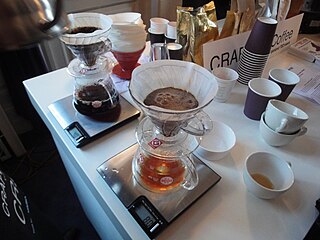
Coffee preparation is the process of turning coffee beans into liquid coffee. While the particular steps vary with the type of coffee and with the raw materials, the process includes four basic steps: raw coffee beans must be roasted, the roasted coffee beans must then be ground, and the ground coffee must then be mixed with hot or cold water for a specific time (brewed), the liquid coffee extraction must be separated from the used grounds, and finally, if desired, the extracted coffee is combined with other elements of the desired beverage, such as sweeteners, dairy products, dairy alternatives, or toppings.

Milk coffee is a category of coffee-based drinks made with milk. Johan Nieuhof, the Dutch ambassador to China, is credited as the first person to drink coffee with milk when he experimented with it around 1660.

Affogato, known in full in Italian as affogato al caffè and gelato affogato al caffè, is an Italian dessert comprising a scoop of gelato or ice cream, either plain milk-flavored or vanilla, topped with hot espresso. Some variations add a shot of amaretto, bicerin, Kahlúa, or other liqueur.
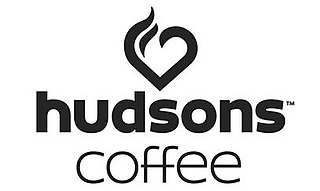
Hudsons Coffee is an Australian chain of coffee retailers. As of August 2013, it comprises 67 stores across Australia, as well as one store at Changi Airport in Singapore. It is owned by the Emirates Group which includes Emirates Airline, the Costa Coffee franchise in the United Arab Emirates, and Left Bank lounge bar and restaurants in Dubai, Abu Dhabi, Oman and Southbank in Melbourne.

Latte art is a method of preparing coffee created by pouring microfoam into a shot of espresso and resulting in a pattern or design on the surface of the latte. It can also be created or embellished by simply "drawing" in the top layer of foam. Latte art is particularly difficult to create consistently, due to the demanding conditions required of both the espresso shot and milk. This, in turn, is limited by the experience of the barista and quality of the espresso machine. The term also applies to other beverages containing milk foam, such as cappuccino and hot chocolate.

Monorail Espresso is a coffeehouse in Seattle. It is notable as having been founded as the first espresso cart in the world. An espresso cart is a food cart from which a barista can make espresso. The business now operates as a walkup window with multiple locations.
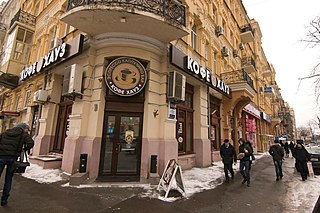
Kofe Khauz is a chain of coffee shops in Russia and Ukraine. The company has currently over 200 stores. It is based in Moscow and was founded in 1999.

Freken Bock is an art-cafe in Taganrog created near the parents' house and the monument of Faina Ranevskaya in 2009.
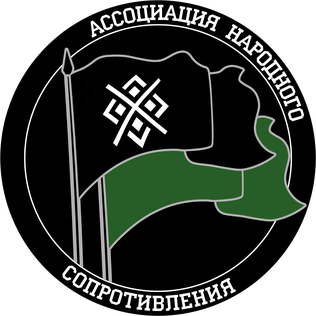
The Popular Resistance Association is a Russian national anarchist political organization. Founded in 2016 by a number of former activists of People's Will, NBP, and other movements
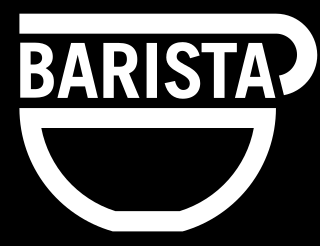
Barista is a small chain of coffee shops in Portland, Oregon, in the United States. Owner Billy Wilson opened the original location in Northwest Portland's Pearl District in 2009; subsequent locations opened in Northeast Portland's Vernon neighborhood in 2010, in downtown Portland's Hamilton Building in 2012, and in Northwest Portland's Northwest District in 2013. Barista also operates a fifth shop in Pine Street Market called Brass Bar.



















